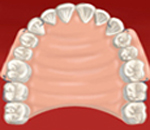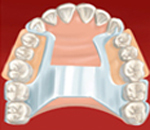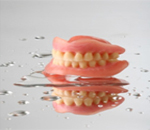Removable partial dentures replace only part of the teeth on a jaw. It can be inserted or removed at will.
Prostheses fully Resin
 Through an indentation made in the cabinet, the technician carries a plate in pink resin in which artificial teeth are embedded in resin or ceramic. Hooks are positioned strategically at the prosthesis to stabilize and retain during chewing and speech. The device relies solely on the gums. These acrylic dentures are easy and quick to perform. They are also inexpensive and often serve as temporary prostheses.
Through an indentation made in the cabinet, the technician carries a plate in pink resin in which artificial teeth are embedded in resin or ceramic. Hooks are positioned strategically at the prosthesis to stabilize and retain during chewing and speech. The device relies solely on the gums. These acrylic dentures are easy and quick to perform. They are also inexpensive and often serve as temporary prostheses.
Prostheses metal frame (or Stellite)

These are more sophisticated devices, to better protect the gums and remaining teeth. In general, two successive footprints are required, after which the technician performs a metal frame. It is similar to a skeleton that serves as scaffolding to support the Pink resin and artificial teeth. With metal frame, these prostheses can rely not only on the gum, but also on the teeth, which better distributes forces. The remaining natural teeth in contact with the hooks may be slightly cut to stabilize the camera, even if they are fragile crowned.

The brackets on the teeth
Some hooks on the front teeth can be unsightly. It is possible to achieve more aesthetic brackets or to use more sophisticated systems called attachments, which allow to remove while ensuring the stability of the unit.
Complete dentures can replace all the teeth on a jaw. They can be inserted and removed at will.
Design of the prosthesis
 The achievement of complete dentures requires a series of steps with high precision. Indeed, two or more fingerprints are required to record very precisely the position of the gums, tongue, lips and cheeks.
Using snaps:
If the contact surface between the prosthesis and the gum is not sufficient, or if saliva is lacking, it can stabilize the prosthesis using press studs placed on implants.
The achievement of complete dentures requires a series of steps with high precision. Indeed, two or more fingerprints are required to record very precisely the position of the gums, tongue, lips and cheeks.
Using snaps:
If the contact surface between the prosthesis and the gum is not sufficient, or if saliva is lacking, it can stabilize the prosthesis using press studs placed on implants.
Monitoring
When wearing a full denture for the first time, there must be a period of adjustment, especially for food. In the weeks following the implantation of the prosthesis, many adjustments may be necessary in order to perfect its morphology and ensure optimum comfort. Over time, it is possible that the bone and the gum of the jaw collapse and result in a loss of stability of the prosthesis. We remedy this situation by providing a "rebasing" that will fill the spaces between the denture and gum.

A removable prosthesis is a dental device that can be inserted and removed at will. This type of prosthesis requires a period of adjustment and regular monitoring.
Adaptation
In earlier times, the mechanism may seem large, irritating or unstable. We recommend you, from the beginning, to wear it as often as possible so that adaptation can be done in a short time. If you feel discomfort or to supply you maintain a good speech, do not hesitate to report any inconvenience that we may create the best comfort solutions.
Settings
During the weeks following the installation, successive settings should be made in the dental clinic to ensure a good adaptation of the device to your jaw and your mout
Maintenance
 The unit should be cleaned at least twice a day after meals, using a stiff brush (reserved for this purpose) and a toothpaste or a specific product for that there is no deposit .dropoff window The remaining teeth must be brushed and the gum in which the prosthesis is based.
Removable appliances should preferably be worn day and night. If the prosthesis is not worn at night it is more hygienic to let it dry as the soak in a glass of water. If your prosthesis remained dry during the night, you can moisten with warm water before replacing in the mouth.
There are also cleaning products, effective overnight, which ensure the durability of the device.
The unit should be cleaned at least twice a day after meals, using a stiff brush (reserved for this purpose) and a toothpaste or a specific product for that there is no deposit .dropoff window The remaining teeth must be brushed and the gum in which the prosthesis is based.
Removable appliances should preferably be worn day and night. If the prosthesis is not worn at night it is more hygienic to let it dry as the soak in a glass of water. If your prosthesis remained dry during the night, you can moisten with warm water before replacing in the mouth.
There are also cleaning products, effective overnight, which ensure the durability of the device.








